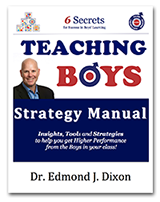 Brainwriter (1)
Brainwriter (1)
Humor in classrooms is often seen as a “subversive” activity that takes students away from what they are supposed to be focused on. But, with boys especially, their sense of humor and attempts to make things funny is a constant that teachers always have to deal with. What I have discovered in my research, however, is that humor turns out to be a powerful learning tool for boys and if we harness it as teachers it can bring tremendous benefits to to our students–and to us!
One of the first characteristics is that it increases focus. We have a strategy called Brainwriter that tickles boys funny bones, but also uses movement to improve their oral language, comprehension and creativity around your curriculum. It requires a bit of structure and that is why I’m going to introduce it in three stages.
This week we’ll describe how you set it up and then, in future posts we’ll show you how to use it. Here’s an introduction:
What is Brain-Writer? A story is narrated by one student while others create physical visualizations. It can be used in groups of 2-6 participants.
Why does it engage students? Creating a Brain-Writer story is both fun and challenging. The activity has multiple ways of participating for each group member.
How does it improve learning? Students create neural connections by linking experiential understanding with oral language while at the same time gaining an emotional attachment to the curriculum. This strategy helps students consolidate learning in preparation for further oral or written expression.
When can it be used in class? To assess prior knowledge of curriculum topic, to demonstrate processes and multiple connections within curriculum matter, and as a culminating task for lesson/ unit evaluation. It is also excellent as a pre-writing activity.
STEP-BY-STEP INSTRUCTIONS
- Demonstrate for the class with 4 students (or 2 for primary!). One in a chair (Brain-Writer) and three others sitting in a parallel line on the floor beside the Brain-Writer (Visual Images).
- Narrate a story that is familiar to the class, prompting the Brain-Writer to type on an invisible keyboard and repeat what you say. After introducing a character, the Brain-Writer points at a Visual Image who must jump up and become that character.
- The Visual Image cannot do anything or speak, unless the Brain-Writer puts words into that character’s mouth.
- Visual Images are called into life as needed.
- Once a story is finished, the group rotates so a new Brain-Writer can tell the story.
Primary Example (2 Students)
Junior Example set-up
(4 Students)



